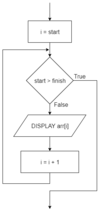9.2.2 Planning and designing Flashcards
Name the four basic data types
Integer, float, string, boolean.
Name the 2 basic data structures
- Arrays, which could be multidimensional (arrays of arrays).
- Records, which is a single data item consisting of a number of named fields.
True or False - in this course, arrays must contain the same data type.
True!
In some languages like C and Java when the array is declared so must the data type of all the elements in the array.
However, many real-world languages like Python and JavaScript allow for arrays to be composed of many different data types.
Name and describe the 3 control structures used in algorithms and the various sub-types of each.
- Sequence - operations in an algorithm are performed in order.
-
Decision (branching) - different actions are taken depending on a particular condition.
- Binary decision (IF…ELSE…ENDIF)
- Multiway decision (CASEWHERE…ENDCASE)
-
Iteration (looping) - the same series of steps are
- Pre-test loop (WHILE…ENDWHILE)
- Post-test loop (DO…WHILE)
- Counting loop (FOR…NEXT)
Draw the following algorithm flowchart symbols:
- Terminators (BEGIN/END)
- Process
- Decision
- Input/output
- Subroutine call

How would the following algorithm snippet be represented with a flowchart?
FOR i = start to finish
DISPLAY arr(i) NEXT i
Since there is no counting loop in a flowchart, the algorithm would have to be implemented with a pre-test loop.

Write an algorithm to find and return the minimum value of an array called numbers, given that each element in the array could take on any value.
BEGIN minimum
min = numbers(1)
FOR i = 2 to length of numbers
IF numbers(i) < min THEN
min = numbers(i)
ENDIF
NEXT i
RETURN min
END minimumWrite an algorithm to find and return the maximum value of an array called numbers, given that each element in the array could take on any value.
BEGIN maximum
max = numbers(i)
FOR i = 2 to length of numbers
IF numbers(i) > max THEN
max = numbers(i)
ENDIF
NEXT i
RETURN max
END maximumWrite an algorithm to return the sum of all the elements in an array called numbers.
BEGIN sum
sum = 0
FOR i = 1 TO length of numbers
sum = sum + numbers(i)
NEXT i
RETURN sum
END sumWrite an algorithm to return the average of all the elements in an array called numbers.
BEGIN average
sum = 0
FOR i = 1 TO length of numbers
sum = sum + numbers(i)
NEXT i
RETURN sum / length of numbers
END averageWrite an algorithm SimpleFind(item, arr) that searches for a value item in an unsorted array arr and returns True or False, depending on whether the item was found. The algorithm need not terminate once the element has been found the first time.
Because the data are unsorted, a linear search must be used.
BEGIN Find(item, arr)
found = False
FOR i = 1 TO length of arr
IF arr(i) = item THEN
found = True
END IF
NEXT i
RETURN found
END
Write an algorithm LinearSearch(item, arr) that returns True if item is found in arr or False otherwise. The algorithm should terminate once the item is found and only contain a single RETURN statement.
BEGIN LinearSearch(item, arr)
found = False
index = 1
WHILE index <= length of arr AND found = False
IF arr(index) = item THEN
found = True
END IF
index = index + 1
ENDWHILE
RETURN found
END LinearSearchWhat are the two types of file access and how do they differ?
- Seqential - data is stored in a continuous stream, and must be accessed from beginning to end.
- Random access - Used to store records, an application is able to jump straight to any individual record.

What is a priming read?
In a sequential file, a pre-test loop is used to repeatedly read from the file, which exits when EOF or a sentinel value is found. There needs to be a priming read before this condition is checked so that the algorithm will work if the file is empty.

What is a sentinel value?
A sentinel value is a “dummy value” used to indicate the end of data within a file.
Note: While it is more commonly applied to sequential files, a sentinel may also be used when getting an unknown number of inputs from the user. For example, in a CLI application the user might be asked to repeatedly enter data, or a blank value to exit. In this case, the blank value is the sentinel.


